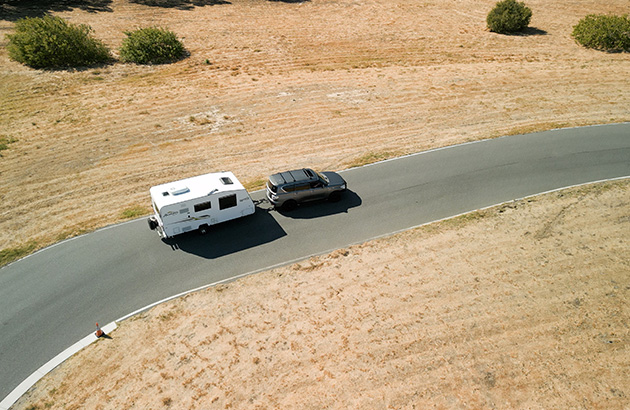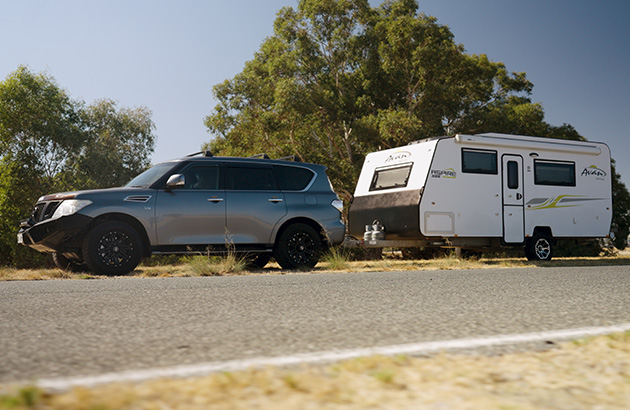Travel & Touring | Camping & Caravanning
By: Brendan Batty
Caravan sway, or snaking, is one of the most unsettling experiences you can ever have on the road, and it can, and does, lead to disaster.
In this video, caravan expert Mike Sandilands from Driver Risk Management shares how caravan sway happens, and how to prevent it. He talks through the steps to ensure you can prevent sway on your next journey, and travel safely while towing your caravan.
Several factors cause caravan sway, but so we are clear, no amount of sway is acceptable, especially the inherent type that just develops at a certain speed, no matter the conditions. If you are experiencing caravan sway every time you tow, no matter how minor, something is wrong.
Sway is when the caravan is snaking or swerving behind the car. Because the caravan is following a swerving path, while the vehicle is mostly still going straight, it’s actually going faster than the car towing it. Once we get our heads around that, understanding and dealing with sway is relatively easy.
RELATED:
Caravan Weight Distribution »
There are many reasons a trailer could be ‘going faster’ than the car towing it. As a car brakes down a hill, the trailer’s inertia will want it to keep moving forwards at the speed it was going. A gust of wind, hitting the trailer like the sail of a yacht, could add energy to the trailer, knocking it off course. Bumps or undulations in the road or even a sudden and sharp steering action to avoid a pothole or some wildlife, could force the suspension to work harder on one side, disrupting the trailer’s balance.
Sway is also more likely to develop when the caravan carries most of its mass at its ends. Sometimes this is poor design, like when trailer manufacturers fit heavy accessories right back (like wheel carriers, toolboxes or water tanks) to lighten the hitch load. Other times it’s because the most convenient storage spaces are at the ends of the caravan – under the bed and on the drawbar, and we Aussies love packing as much as we can.

So, there are a few things we can do. The first is to steer clear of caravans or trailers that have been ‘balanced’ by the manufacturer with heavy accessories on the rear. That’s usually a mark of poor design. Caravans are best when they carry most of their mass down low and as close as possible to the axles.
When packing our trailers or caravans, aim to pack the heaviest things over the axles (working within the constraints of our caravan’s layout, of course). Even consider spreading some of the load onto the tow car. Bikes might be better placed on the roof of the car, rather than the back of the caravan, for instance. Only pack the lightest things up high or at the back.
The best scenario is to have the caravan balanced so there’s about 10 per cent of its total weight on the tow ball when it’s under tow, without resorting to excessive mass on the rear. A little over or under is okay. Caravans handle best when they sit level. Nose up or down shifts weight to just one of the axles and reduces the contact it has with the road. Take some air out of the tow vehicle’s front wheels, too, to increase their connection with the road.
Sway is best managed by slowing down the caravan. Although there’s a lot of commentary saying you should accelerate out of sway, there’s a whole host of reasons why that’s a bad idea. More than likely, you’ll just increase the chance of a crash, and you’ll be going faster when it happens.
There is a range of great aftermarket products to deal with caravan sway, but most people probably have the means of slowing down their caravan at their fingertips already – the override function on your electronic brake control. Pressing it will apply the caravan’s brakes only, very effectively slowing it down and bringing it into line with the car. It’s a great skill to know exactly where that button is and to practice pressing it without looking at it, so you know you can do it in an emergency.

That’s essentially how all the sway control systems work. While they vary in sophistication, all of them apply the caravan’s brakes, when they detect sway, to slow it down to the same speed as the car. Some, like ESC from AL-KO, apply all the brakes at once. Others, like Dexter Sway Control, apply individual brakes to slow wheels one side at a time.
Need some more caravan advice before setting off?
We're running free caravan safety training sessions in Perth and regional WA to help you travel safely.
Last updated: June 2024
